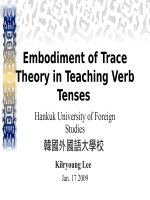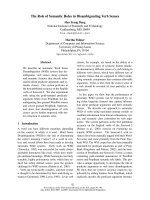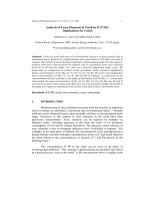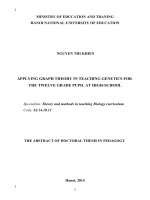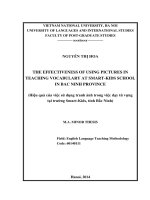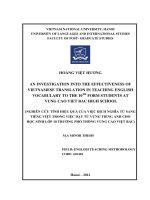Embodiment of Trace Theory in Teaching Verb Tenses
Bạn đang xem bản rút gọn của tài liệu. Xem và tải ngay bản đầy đủ của tài liệu tại đây (565.74 KB, 54 trang )
Embodiment of Trace
Theory in Teaching Verb
Tenses
Hankuk University of Foreign
Studies
韓國外國語大學校
Kilryoung Lee
Jan. 17 2009
Background
There have been many studies related
to language forms and the grammatical
errors Korean students often make when
they use English.
One of the most frequent errors made
by Korean students are verb tense errors
(Chung and Chung, 1998).
Why are English verb tense difficult?
Why are English verb tense difficult?
Verb tense is one of the most difficult grammar
parts in mastering English since it is concerned
with invisible concept of ‘time’.
Each of verb tenses are taught separately and
inconsistently. Simples present /present continuous, simple past/present
continuous, future continuous/present perfect
Koreans are not as much sensitive about verb
tenses as English native speakers.
It is urgently needed to teach the verb tenses
more effectively.
Many scholars such as Asher (1977), and
Walter, Patty and Becking (1981) have
found that physical activities can enrich the
language learning in various ways.
The idea of physical motion’s advantage on
the language learning ability is very closely
related with TRACE THEORY of learning.
Trace Theory-1
Theory that if we are correctly said to
remember some fact or event (as against
relearning it, guessing it, and so on) there must
be some physiologically identifiable trace in
the brain which carried the information in
question right through from the time when we
first learnt it (Bursen, 1978).
The trace need not be a physical object; it
could be an electrical circuit or such like.
Trace Theory-2
Trace theory of memory (Katona, 1940)
The more often or the more intensively a
memory connection is traced, the stronger
the memory association will be and the
more likely it will be recalled.
Memory is stimulated or ‘traced’ and
increased when it is closely associated with
motor activity (Brown, 2001).
Trace Theory-3
Retracing can be done verbally (e.g., by
rote repetition) and/or in association with
motor activity. Combined tracing activities,
such as verbal rehearsal accompanied by
motor activity, hence increase the
probability of successful recall.
In this study, a new teaching method called
‘Teaching Verb Tenses through Actions
(TVTA)’ (Song & Lee, 2007) is suggested
to help students understand verb tenses
easily.
In this study, verb tenses are associated with
spatial time. They are represented in hand
signal actions.
Learning languages with physical actions
can enhance language learning and reduce
learners’ stress.
These actions could be very expressive and
helpful for L2 learners.
The purposes of this study
The purposes of this study
To corroborate the new teaching method
called ‘Teaching Verb Tenses through
Actions (TVTA)’
To help students use appropriate forms
of verb tenses
Review of the literature
Review of the literature
e
e
1. Time Orientation Metaphor
Lakeoff and Johnson (1999) suggest that we have a rich
and complex notion of time built into our conceptual
system. All of our understandings of time are relative to
other concepts such as motion, space, events and etc.
The most basic metaphor for time: They describe that the
location of a speaker is considered as the present, the
space in front of the speaker is regarded as the future, and
the space behind the speaker indicates the past.
2. Total Physical Response (TPR)
Asher(1997) believes the method that involves
game-like movements can reduce a learner’s
stress and create a positive effect on the language
learner.
It attempts to teach languages through various
physical actions.
3. The Effectiveness of Physical Activities
Walter & Marjorie (1981) claim that body movements are
very expressive and helpful for communication. Physical
activities can enhance and enrich the language learning
for students in various ways. They report that the memory
of objects and movement was much stronger than the
verbal learning.
Young students can learn the target language very easily
when they learn through physical activities (Lee, 1971).
Research Questions
Is Teaching Verb Tenses through
Actions (TVTA) effective for students to
learn verb tenses?
Methodology
Subjects:
- 61 middle school students (14-15 years
old) in Seoul, Korea
- They were taught a course called
‘Intensive grammar lesson’ for 10 weeks.
- The Experimental Group : 31 students (F:16/ M:
15)
- The Control Group : 30 students (F:14 / M: 16)
The Data Collection and Procedures
Pre-test / Post-test
To find out the improvement of
students' English ability on learning
verb tenses
Questionnaire
To investigate what they think about
TVTA
1. Pre-test
Pre-test (40 questions of verb tenses) was
conducted.
No significant differences of pre-test
scores
(Mean: Exp. 65.24 / Cont. 65.91)
2. Teaching Verb Tenses through Actions (TVTA)
The students in the experimental group learned TVTA when
using a grammar book whereas the students in the control
group learned verb tenses using the grammar book without
actions.
In TVTA, the time metaphor applies to a spatial schema to
let the students understand the verb tenses more easily and
cognitively.
In TVTA. verb tenses are linked with physical activities and
spatial time schema.
a.
a.
Present Simple
Present Simple
To talk about things that you do
again and again.
If you try to express the present
simple with your hands, you
should follow this hand signal
activity, saying this example
sentence. “ You play soccer.”
The location of the speaker
indicates the present time.
b.
b.
Past Simple
Past Simple
To talk about events that
happened in the past.
It is for things that are finished.
“ You played soccer.”
The space behind the speaker
indicates the past time.
c.
c.
Future Simple
Future Simple
To say that you have decided to
do the things in the future and to
talk about the future.
“ You will play soccer.”
The space in front of the speaker
indicates the future time.
d.
d.
Present Continuous
Present Continuous
To talk about things that are
happening now. Things are still
doing now.
“ You are playing soccer.”
Rotating your hands in the
location of the speaker indicates
the present continuous.
e.
e.
Past Continuous
Past Continuous
To say that somebody was in the
middle of doing something. It’s
for a time before now.
“ You were playing soccer.”
Rotating your hands in the space
behind of the speaker indicates
the present time.
